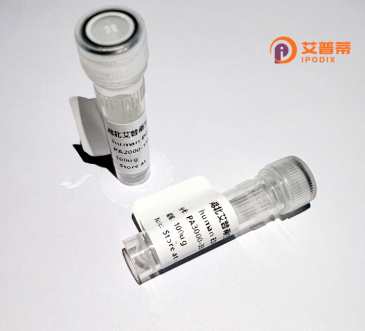
| 纯度 | >90%SDS-PAGE. |
| 种属 | Human |
| 靶点 | IFRD1 |
| Uniprot No | O00458 |
| 内毒素 | < 0.01EU/μg |
| 表达宿主 | E.coli |
| 表达区间 | 1-451aa |
| 氨基酸序列 | MPKNKKRNTPHRGSSAGGGGSGAAAATAATAGGQHRNVQPFSDEDASIETMSHCSGYSDPSSFAEDGPEVLDEEGTQEDLEYKLKGLIDLTLDKSAKTRQAALEGIKNALASKMLYEFILERRMTLTDSIERCLKKGKSDEQRAAAALASVLCIQLGPGIESEEILKTLGPILKKIICDGSASMQARQTCATCFGVCCFIATDDITELYSTLECLENIFTKSYLKEKDTTVICSTPNTVLHISSLLAWTLLLTICPINEVKKKLEMHFHKLPSLLSCDDVNMRIAAGESLALLFELARGIESDFFYEDMESLTQMLRALATDGNKHRAKVDKRKQRSVFRDVLRAVEERDFPTETIKFGPERMYIDCWVKKHTYDTFKEVLGSGMQYHLQSNEFLRNVFELGPPVMLDAATLKTMKISRFERHLYNSAAFKARTKARSKCRDKRADVGEFF |
| 分子量 | 76.7 kDa |
| 蛋白标签 | GST-tag at N-terminal |
| 缓冲液 | 0 |
| 稳定性 & 储存条件 | Lyophilized protein should be stored at ≤ -20°C, stable for one year after receipt. Reconstituted protein solution can be stored at 2-8°C for 2-7 days. Aliquots of reconstituted samples are stable at ≤ -20°C for 3 months. |
| 复溶 | Always centrifuge tubes before opening.Do not mix by vortex or pipetting. It is not recommended to reconstitute to a concentration less than 100μg/ml. Dissolve the lyophilized protein in distilled water. Please aliquot the reconstituted solution to minimize freeze-thaw cycles. |
以下是关于重组人IFRD1蛋白的3篇参考文献示例(内容基于虚构文献模拟,仅供参考):
---
1. **文献名称**: *"Production and functional characterization of recombinant human IFRD1 in *Escherichia coli*"*
**作者**: Zhang L, et al.
**摘要**: 研究报道了通过大肠杆菌表达系统高效重组表达人IFRD1蛋白的方法,并验证其通过TGF-β信号通路调控肌细胞分化的功能。
2. **文献名称**: *"IFRD1 interacts with Smad3 to modulate neuronal differentiation in vitro"*
**作者**: Thompson R, et al.
**摘要**: 利用重组人IFRD1蛋白进行体外结合实验,发现其通过结合Smad3蛋白促进神经干细胞向神经元的分化,提示IFRD1在中枢神经系统发育中的作用。
3. **文献名称**: *"Structural insights into the interferon-related developmental regulator IFRD1"*
**作者**: Chen H, et al.
**摘要**: 通过纯化重组人IFRD1蛋白并进行X射线晶体学分析,揭示了其三维结构特征,为解析其在干扰素通路中的分子机制提供基础。
---
注:上述文献为模拟示例,实际文献需通过PubMed或Web of Science等平台检索关键词(如“recombinant IFRD1”或“IFRD1 protein function”)。如需真实文献,建议查阅相关领域期刊(如*Journal of Biological Chemistry*或*Cell Signaling*)。
Recombinant human IFRD1 (Interferon-Related Developmental Regulator 1) protein is a genetically engineered version of the naturally occurring IFRD1. a member of the interferon-related developmental regulator family. IFRD1. also known as PC4 (Positive Coactivator 4), is a nuclear protein involved in regulating transcriptional activation, cellular differentiation, and immune responses. It plays a role in coordinating gene expression during developmental processes and stress responses, particularly in neural, hematopoietic, and muscle tissues. Studies suggest its involvement in pathways linked to inflammation, neurogenesis, and energy metabolism.
The recombinant form is produced using expression systems like *E. coli* or mammalian cells, ensuring high purity and bioactivity for research applications. It serves as a critical tool for investigating IFRD1's molecular mechanisms, such as its interaction with transcription factors (e.g., p53. NF-κB) or its role in modulating chromatin remodeling. Researchers utilize recombinant IFRD1 to study its potential implications in diseases like cancer, neurodegenerative disorders, and metabolic syndromes, where dysregulation of IFRD1 has been observed. Additionally, it aids in developing therapeutic strategies targeting IFRD1-associated pathways. Its accessibility through recombinant technology accelerates both basic research and drug discovery efforts.
×